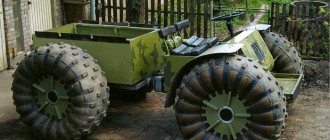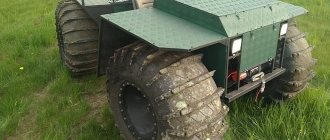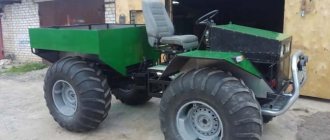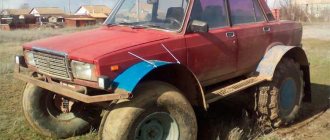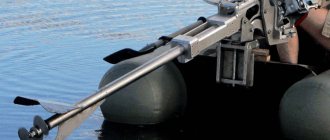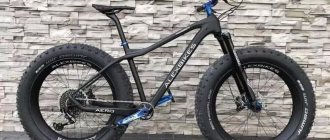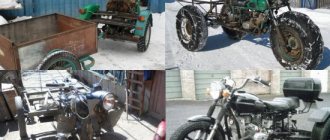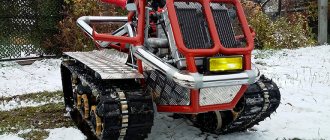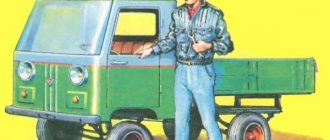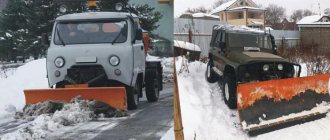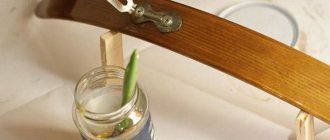For any all-terrain vehicle, the decisive condition for excellent cross-country ability is the use of the right tires.
But the cost of a suitable kit is considerable, because it is often produced either in small quantities or by special order.
But it’s quite possible to make low-pressure tires yourself. This work is labor-intensive and requires patience and attention. The finished product has a characteristic name - odorishi.
How to make tire rims with your own hands?
For any all-terrain vehicle, the decisive condition for excellent cross-country ability is the use of the right tires.
But the cost of a suitable kit is considerable, because it is often produced either in small quantities or by special order.
But it is quite possible to make low-pressure tires yourself . This work is labor-intensive and requires patience and attention. The finished product has a characteristic name - odorishi.
What are buds and what are they for?
Tires (also known as low-pressure tires) are huge tractor, truck or helicopter tires that have been stripped of excess rubber.
Thanks to the large area of such wheels and their low pressure on the surface, an ordinary passenger car equipped with them becomes a real SUV .
With encouragement, Niva and UAZ can overcome a wide variety of obstacles - fields, deserts, rocky and marshy soil.
It is difficult for hunters and simply those who like to ride in difficult terrain to do without wheels with low pressure.
Making such tires yourself is not a problem. For this, the most common tools like a knife or winch . It will still take a little skill.
Before you start creating low-pressure tires, you need to clearly understand what exactly they will be needed for , that is, in what conditions, where exactly they will be used.
- primarily for driving on dirty, bumpy roads and rural roads - then you need to use a self-cleaning tread;
- If we go through swamps on tires, we will need to lower the tread grooves a little so that the grip becomes as good as possible;
- In snow drifts and sand, it is better to drive on tires on which the tread pattern elements are as close to each other as possible.
You need to think about the above in advance.
Studying the instructions
What tools will be needed? The set is ordinary: knives and a sharpener, an awl, a hammer, wire cutters and a winch. So, the tools are ready, the source code is already in the garage. It's time to get to work, as a result of which we will get homemade low-pressure tires.
Step 1. Essentially, we will cut out the new tread pattern, so we mark the pattern itself on the wheel with a marker.
What pattern should I apply? It all depends on your imagination and on what “feats” you expect from new wheels. Most often, car enthusiasts draw a “Christmas tree”.
Step 2. Next, we make a cut in a circle inside the wheel, which will allow you to remove the wire. We mark and cut out small rectangles along the inner circle. Through them you can see the same wire that we pry up and pull out with the help of a winch.
Step 3. Based on the created tread pattern, we make side cuts along the perimeter of the circle. We grab the rubber that protrudes at the place of the cut with pliers and pull it with a winch so as to “pull out” the extra layer of the wheel (according to the picture).
The process of creating low pressure tires
To make low-pressure tires for a UAZ, Karakat or Niva, you need to create the tire itself, as well as a strong metal base to attach it to.
To create your own wrappers you will need:
- The main material is old tires for trucks such as Gaza-66, Kraza 255 (VI-3 tires), ZIL 131. Tires from helicopters, tractors and small aircraft are also perfect. If the tires have a “chewed” inner part, they should not be used. A hole may form in such rubber after the top layer is removed. As a result, they will simply have to be thrown away.
- An awl, a knife (construction knife), a set of blades and a sharpener for straightening them. When in contact with durable truck tires, the blades quickly dull and become unusable, so you can’t do it alone.
- A special template made of a thin steel sheet or thicker cardboard, as well as chalk or a marker for outlining the template.
- Clamps (maximum strength). The best ones are those that straighteners use to clamp the bodies of crumpled vehicles when they try to straighten them. A standard clamp will also work for stripping tires , but you will need to be very careful. You can use the workflow with ordinary wire cutters.
- A winch (automatic or manual) and a cable to tension the part of the tread that we will cut off. It can also be tightened using a manual gearbox.
You may also need a hammer (for straightening).
To make the tires airy, large tires will need to be freed of excess rubber on the tread and sidewalls. It is also necessary to remove the seat cores and the base of the cord (the inner protective layer of the tire).
- thoroughly clean the tire from all dirt and then dry it;
- using a template, using a marker or chalk along the entire circumference of the wheel, we create a tread pattern (the way it will become after some of the unnecessary rubber is removed).
- We make a cut along the inner perimeter of the tire to get rid of the wire . It is better to make the cut with a construction knife. It is convenient because you can set the length of the blade on it.
- In the area of the cut, mark rectangles with a marker and begin cutting .
- Through the holes formed in the tire we will be able to see the wire, which we will get rid of.
- We fix the tire with an iron rod so that it does not move, and pry up the wire with a hook , and remove it from the tire with a winch. You can also remove it with a screwdriver, but this will require a lot of effort.
Now we start stripping the tire:
- We make cuts along the perimeter of the tread circle we drew , digging a little deeper into the rubberized base of the cord;
- using pliers we fix the resulting hole ;
- and peel off the rubber that has peeled off using a winch .
To make things go easier and faster, we cut it with a knife.
- gradually peel off unnecessary layers of rubber and cord from the tread surface and sides until only one frame remains;
- clean the surface using sandpaper (if necessary, straighten it with a hammer).
The camera for the future wheel is ready.
- We create a new tire frame . We weld the wheel rims with the plates. You can also create low-pressure rims yourself. For this, the most ordinary aluminum basin and fire hose (for fastening) will do.
- Grinding the frame.
- We put the support camera on the frame.
We pump the tire and can install it on our car.
How to strip tires from GAZ 66 to UAZ
Tires from GAZ 66 are most often useful for this kind of work, since there are few cord layers, and it is not so difficult to make light wheels from them. But many professionals in their field still note that these tires become very shaggy after peeling. These wheels wear out quickly and may not last long. Therefore, when cutting the side strips, you should work more carefully so as not to cut the threads too much. But the tires are not hard, which is very good for an all-terrain vehicle.
Obodrysh from GAZ 66
Car enthusiasts also often ask: which tires to rip off for a height of 900? For this purpose, tires with a 16-inch seat diameter and 850 mm in outer diameter are suitable. These are tires such as I-324, NKF-8 from the PTS-4 tractor cart, and wheels from the L-163 combine. After peeling, it will be possible to make them just about 900 mm in height.
Buying ready-made wheels with rims specifically for an all-terrain vehicle is very expensive, so you can try to do everything yourself. The main thing is to find donor tires and be patient. And if there is fear, then you can give such wheels to professionals for stripping. It will still cost less than a new set of tires.
Well, this is the beginning of a new project, we will build an all-terrain vehicle. I'm on VK ************************************* I'm on Instagram.
Peeling ID-P 284. Manufacturing process.
In this video I show the technology for stripping ID-P 284 wheels. Wheels from a GAZ-66 were stripped using a similar technology.
I'm building a new all-terrain vehicle. I cut Trom8 tires
I started cutting Trom8 tires with a rotary hammer.
Stripping gas 66 tires part 3.
strip off the wheels for an all-terrain vehicle
we peel off the wheels of the KF 105a for an all-terrain vehicle.
tire stripping OI 25 in 5 minute review
Manual wheel stripping
A simple way to strip wheels by hand.
Vi 3 wheel stripping
I tear out the outer tuft, mark the fangs with chalk, cut grooves with a grinder, grab the outer layer with pliers and trim it with a craft knife.
How to peel Ural OI-25 tires
Stripping KF-97. Manufacturing process. For one day.
This video shows my technology for stripping KF-97 tires (tyres from a nine-ton truck).
I'M BUILDING AN ALL-TERRAIN VEHICLE. Issue No. 3. Peeling RP - 25.
Hi all! Another video about building an all-terrain vehicle. Watch, subscribe, like. .
How to strip KF-97 tires
Far East. tel.89146640847 WhatsApp. Alexander. VKontakte Instagram.
We peel off the wheels for an all-terrain vehicle. Or what to do with used tires, part 2.
In this video we will continue the story about cutting used rubber for an all-terrain vehicle. We will consistently show and tell you what and how to do. Link to .
New wheels for the all-terrain vehicle. Run-in of KF-97.
I finally managed to replace the wheels on the all-terrain vehicle. Previously there were OBD-66 OBDs, now I have installed KF-97 EADs, and as always.
Which wheels are best for an all-terrain vehicle?
Far East. tel.89146640847 WhatsApp. Alexander. VKontakte Instagram.
HOW THE WHEELS WERE BORN - ROOMS FOR MOTOR BLOCKS. Making napkins. Stripping the KF-97 tire.
Stripping the IP-184 tire. Lesson 1.
Address: Tver, st. Industrialnaya, 8 Mobile: 8-920-178-39-00 Tel. E-mail: [email protected] Working hours: Mon-Fri: 11.00 - 17.00.
How to make a disk for an all-terrain vehicle.
Far East. tel.89146640847 WhatsApp. Alexander. VKontakte Instagram.
A simple homemade disk for the Karakat all-terrain vehicle swamp vehicle. disc for cheerleaders
simple disks for low pressure sheets. simple discs for karakat. rims for tires of all-terrain vehicle swamp vehicle. discs for refreshments. wheels for tires.
Rip-off vi 3. Review. Pads for all-terrain vehicles. SHERPAs
Stripping VI-3, (one beam) Part 2
Stripping KF-97 with improvised means
I tried to peel it for the first time. For the sake of 2 wheels, I didn’t want to make a stripping machine. I adapted it to a boat trailer. In quarantine, what came to my mind.
Stripping Omskshina OI-25 Ural.
I'm trying to peel off an Omsk tire.
Roughing tires VI-3 KrAZ - 255
Technology for stripping VI-3 KrAZ-255 tires. Tire stripping machine. Video. Technology roughing tires VI-3 KrAZ -255. A machine for Stripping tire.
All-terrain vehicle on hurricanes VI-203 part 11
Tires Hurricane VI-203.
Caracat wheels.
Homemade wheels for an all-terrain vehicle.
Homemade wheels for a homemade all-terrain vehicle.
All types of tires for peeling and sale and tubeless wheels for them.
We buy and exchange used tires and tubes for all-terrain vehicles. We produce tubeless wheels for all types of tires. We provide training courses on .
Pontoon wheels for all-terrain vehicle Samurai
Testing trial pontoon wheels to increase the buoyancy of the Samurai. Manufacturer's website Composition Dance Monster.
How to strip tires
The process of stripping wheels for an all-terrain vehicle.
How to peel KF-97,
tires from the KF-97 tire. encouragement from the devititonka cart. encourage the UAZ.
Wheel rims for all-terrain vehicle part No. 18
Cutting the tread with a chainsaw for tires (Vi 3 KrAZ Laptezhnik)
Cheers from the nine-ton cart
We continue to build an all-terrain swamp vehicle to search for WWII equipment in hard-to-reach places. In this series we will make low pressure tires.
VI 3 made himself a set of all-terrain tires
I decided to sort out the trash in the shed and at the same time find the gearbox from my field. I'll show you what set of all-terrain tires I made for myself from VI-3.
Advantages and disadvantages
Wheels have many advantages over purchased wheels:
- Price. All-terrain wheels are very expensive, which can’t be said about the wheels.
- Such wheels have excellent adhesion to almost any surface, which significantly reduces the risk of accidents.
- The husks weigh relatively little. An “unpumped” passenger car engine will be quite capable of cranking them.
- Low surface pressure due to the large tire area. With encouragement, muddy terrain, quicksand and deep snow become quite passable obstacles. The tire pressure on the surface can be adjusted. They just need to be pumped up or lowered a little.
- Tires with low pressure do not harm the surface soil layers in any way, so you can safely drive an all-terrain vehicle with tires across plowed fields or use it as a tractor in agriculture.
They are also not without some disadvantages :
- You should try to ride less on hard asphalt and concrete surfaces. Otherwise, they will have to be changed very soon .
- A car on such wheels is not very stable. It’s better not to make sharp turns on it, and you shouldn’t drive it fast at all.
- Wheels wear out much faster than normal ones.
- Encouragement is a considerable burden. Transmission and suspension parts with such wheels will have to be changed and repaired more often.
- Low pressure tires are very flexible. This increases their permeability. But due to their increased stretchability, tires get punctured more often than regular tires.
- The car will have to be re-registered - “upgraded” to the status of an all-terrain vehicle.
Making low-pressure wheels with your own hands
Among amateur designers of all-terrain vehicles, low-pressure wheels of their own production are very popular. The beginning of the history of the use of this type of propulsion by enthusiasts of homemade all-terrain vehicles can be considered the mid-sixties of the last century. It was then that the first timid attempts were made to master the production of wheeled vehicles capable of moving with equal success through wetlands and virgin snow. All these machines were equipped with low-pressure pneumatics, and became the ancestors of today's homemade products.
Table: characteristics of off-road tires
| Road conditions | Maximum tire load, kgf | Internal pressure in the tire corresponding to the maximum load, kgf/cm2 | Maximum speed, km/h | Mileage rate within the warranty period, no more, km |
| Paved roads | 600 500 | 0,6 0,5 | 70 | 800 |
| Dirt roads | 600 500 | 0,45 0,35 | 60 | 900 |
| Sand, plowing | 600 500 | 0,3 0,25 | 40 | 1500 |
| Virgin snow | 500 | 0,2 | 20 | 1300 |
Distinctive features of low pressure wheels
Why did the designers of caracats like this type of tires made by themselves? The pneumatic has low weight, very high elasticity and pressure on the ground within small limits. All these characteristics, coupled with a large rolling radius, give the all-terrain vehicle amazing maneuverability along with efficiency.
Factory LP wheels
A decent volume of chambers gives the design with such a propulsion sufficient buoyancy. This can be called an additional bonus to the vehicle's cross-country ability. In addition, by filling the inner space of the disk with foam, you can give the all-terrain vehicle additional stability on the water and at the same time reduce the sticking of snow or dirt on the inner surfaces of the wheel.
The simple design of these chassis elements and the absence of problems with finding materials for their manufacture allows you to make a pneumatic passage with your own hands without any special material and labor costs. This made machines built according to this principle very popular among home-made people.
Of course, such designs also have their drawbacks, in particular the short service life of the cameras, but they are overcome by introducing additional elements into the design.
SmotriAvto
Elastic barrel-shaped wheels with a characteristic profile. The tread is made in the form of rigid lugs, which, in addition to increasing cross-country ability, provide additional strength.
Thanks to their high elasticity and low pressure, the off-road properties of this type of wheel stand out from their analogues. Considering that the cost of a set of this type of tires can be several times higher than the cost of a set of regular tires, many car owners are quite serious about making them on their own.
We recommend reading: Where can you provide a plot of land for free use?
However, before starting work, you will need to prepare the necessary tools.
- First of all, you will need to find a suitable source material from which the tires will be made. Helicopter and airplane tires, which are initially designed for increased loads and difficult conditions, are excellent for these purposes. However, they are not so easy to find, so truck tires are actively used by car enthusiasts.
How to make a pneumatic duct from a walk-behind tractor
In order to take on the creation of such an all-terrain vehicle, an amateur designer must solve the following problem: for what purpose is the future vehicle intended. Here you need to clarify the desired number of seats, the weight of the maximum luggage, the season of use and for what conditions the device is intended.
And now the idea is ready, the goal is visible, which means we can move on to the issue of selecting the elements of the all-terrain vehicle. Here you need to decide on the type and model of the engine, the composition of the transmission, the design and type of frame, the equipment of the cabin and other elements. One of the main characteristics that needs to be paid attention to when creating an all-terrain vehicle is the choice of the propulsion system formula.
After analyzing and comparing all desires and possibilities, you can make the final choice of the required all-terrain vehicle design. At this stage of activity, a project for a homemade all-terrain vehicle is a necessary condition for its completion.
Stripping tires for all-terrain vehicles
For such a difficult task you will need not only tires and a garage, but also many related tools. The most necessary ones include:
It’s better to prepare everything in advance so as not to slow down the whole process later. Stripping the wheels will take a long time, so you will need to be patient.
If all the components are available, then you can start. Applying chalk markings is necessary for future drawing of the tread. Moreover, this can be done as much as your imagination allows. But it’s better to draw the simplest one so that there’s less work.
The winch is prepared first; it should be securely attached to the wall or floor. Not far from the winch you will need to equip a tire fixation area. It must be installed and remain stationary while the electric winch is operating. You can make a hole in the concrete floor and insert a crowbar into it, and then put a tire on it. But if your imagination can come up with a more interesting mount, then you shouldn’t hold back. For a stationery knife, you will definitely need replacement blades, since they become dull very quickly during operation.
You may be interested in this About wheel sizes for Lada Granta
Materials for stripping tires
Useful video
It’s not difficult to make rewraps yourself. They provide high vehicle cross-country ability, are cheap and are an alternative to factory all-terrain tires.
It is quite possible to make lightweight tires for an all-terrain vehicle yourself. In common parlance they are also called tire wheels and pneumatic wheels. The basis for future components of the all-terrain vehicle can be used tractor, KAMAZ and KrAZ wheels.
These tires weigh a lot, so to fit them to a regular all-terrain vehicle, you will need to peel off the top layer. And then the question arises: how to peel off the wheels on an all-terrain vehicle? The procedure is quite complex and time-consuming, so you should immediately stock up on patience and strength. The work will have to be very careful, since any awkward movement can ruin the tire forever.
Tires are good
When the required tire has already been selected, you need to prepare it for work. To do this, you will need to wash and dry it, and use a wire brush to remove any stones stuck in the tread. Another important point in the previous work is the choice of premises. It should be spacious and well equipped. A spacious garage could be an excellent option.
We make a pneumatic walker with our own hands from a walk-behind tractor
Choosing a motor for a pneumatic duct
Very often, the lack of sufficient funding leads to restrictions when choosing an engine, therefore, you have to use what is available. These, as a rule, are two- or four-stroke motorcycle engines, and also use old automobile power plants, but much less frequently. If you still have extra money available and when choosing an engine you don’t have to think about its quantity, then you can use the following recommendations:
Four-stroke engines have a number of advantages over their two-stroke counterparts, which is why many designers use them. For example, you can take boxer engines from heavy motorcycles. In such devices, you can also use a motor from a car, which is most suitable for installing it on a homemade tracked all-terrain vehicle. Such an engine has sufficient torque, is also reliable in use, and it has (and importantly) a good price-to-required performance ratio. What type of engine to use - diesel or carburetor - will be your decision.
Both schemes have their advantages and disadvantages. For example, a diesel engine is more economical than a gasoline engine, although in severe frost conditions it can be difficult to start it stably and make it work stably without using additional equipment (preheater). (What can be said about gasoline engines, but to a much lesser extent).
Design of pneumatic wheels
Designers of all-terrain vehicles in many cases use homemade low-pressure wheels.
What is so unusual about pneumatic tires? They have relatively low weight, high elasticity and pressure on the ground within small limits. Such characteristics, along with a large rolling radius, provide the all-terrain vehicle with good maneuverability along with efficiency.
Factory LP wheels
The volume of the chambers determines good buoyancy for the structure, which is an additional advantage for cross-country ability. And if you use foam to fill the space inside the disk, the all-terrain vehicle will be more stable on the water and there will also be a noticeable reduction in the accumulation of snow or dirt.
The simple design of the chassis elements and the ease of finding materials for them makes it possible to manufacture an all-terrain vehicle without much difficulty. But, of course, this also has its drawbacks, for example, the low lifespan of cameras, but the introduction of additional elements allows this to be avoided. Tires for pneumatic all-terrain vehicles are made by craftsmen themselves, using four basic principles:
- The first - 2 sheet metal disks with jumpers between them are attached to a sleeve, after which you need to put on a camera, which is fixed with pieces of conveyor belt. Sometimes a camera can use a protector from another camera.
- The second is to fasten one disk to the bushing, and then attach jumpers to it, and weld or rivet the side rings to them.
- Third - the scheme is similar to the previous construction principle, only a spoke made of sheet metal or pipe is used for the central disk.
- According to the fourth principle, two discs are mounted on the hub, similar to the discs of a motor scooter wheel (split wheel).
Simple caracat 4x4 “logza”
This caracat was built for fishing and hunting trips, as well as for household needs, such as delivering firewood.
The all-terrain vehicle is designed for two people, and can also carry cargo weighing up to 250 kilograms. To build the all-terrain vehicle, the author used the following parts: 1) engine from an IZH-Planet 5 motorcycle 2) axles from a Moskvich 412 car with a gear ratio of 4.22 3) SZD gearbox 4) Tubes and tires from T-150 5) wheels from GAZ-52 6) gearbox from UAZ 7) sprockets with 20 teeth and other chains with a pitch of 19 and 25.4, as well as a chain from an Izh motorcycle
Let us consider in more detail the main stages of building an all-terrain vehicle and the components of its structures.
A transfer case was made from a disabled person's gearbox.
The transition of the CV joint to the flange was made quite simply: a washer was machined, which was put on the cut shaft of the CV joint grenade, and then welded on both sides.
The wheels of the all-terrain vehicle are made of T 150 tubes measuring 530 by 610, and the tires from the same tractor were lightened. The discs were made on the basis of gas 52 discs and 12 inch pipes.
The tire was lightened, leaving 4 layers of main cord. The thickness of the tire along the treadmill and up to half of the sidewall became 6-7 mm. A thickening is left at the place where the belts are attached. The weight of the tire is 36-37 kilograms. the complete wheel itself, consisting of a tube, disk, flipper, and tire, weighs approximately 70 kilograms.
Below are photographs of tire stripping and tread cutting:
This tire was made of radial rubber, the only difference from bias tire is durability. The processing difficulty is approximately the same for both types of rubber. In the photographs of the wheels you can see the old flipper; in the new version it goes under the tire.
Over the long period of operation of the all-terrain vehicle, there were only two punctures in the tubes, both between the disk and the tire. The straps can withstand loads very well and do not break.
This is how the frame fracture unit on an all-terrain vehicle is made: Before the modernization, the caracat had a reverse transfer case, which was assembled from the body of an SZ motorized stroller and the insides of the SZ itself, as well as an Ant motor scooter.
Afterwards, a second box from the UAZ 469 was installed. Thanks to this modernization, the maximum speed of the all-terrain vehicle increased from 40 kilometers per hour to 60 kilometers per hour on a flat surface.
A star from the rear wheel of the Izh-Planet Sport motorcycle is installed on the cardan shaft. It is clamped between the two flanges of the cardan and the axle shank with standard four bolts. The number of teeth on the sprocket is the same as on the standard one. The weak points of the transmission are the strong overhang of the wheel rim. Overloading an all-terrain vehicle also negatively affects the integrity of the axle shafts.
When paired with an additional gearbox, the engine power from the Izh is completely sufficient. Without the extra box, it would be quite difficult to transport heavy loads, especially in marshy areas. that is, without an additional gearbox, the author would not have been able to get out to pick berries, which naturally did not suit him and he installed a gearbox.
Other photos of all-terrain vehicle designs:
For the UAZ gearbox, two housings were machined for additional bearings and seals for the primary and secondary shafts. moreover, threads were cut on the primary and secondary shafts to secure the sprocket hubs. The hubs themselves were also made to match the stars. The advantage of such a design for the author is that spare parts for the UAZ are quite easy to find in his area and at a relatively cheap price.
The chain does not stretch from the box to the bridge; the Izhevsk chain is completely strong enough. The chains were used with a pitch of 19 and 25.4, although a motorcycle chain is of much higher quality than ordinary collective farm chains. In addition, the chain for the Izh motorcycle is sold in almost any specialized store. The gearbox is equipped with 20-tooth sprockets.
How to install Zhiguli wheels
If you have old spare parts for Lada cars, then there are two options for using them. The first is the creation of lug elements based on discs. This procedure requires the following steps:
- remove and clean the disks;
- weld the plates in a certain order, which will act as lugs;
- install lugs using weights and extensions on the base.
If you use pneumatic tires from Zhiguli, then it is advisable to install winter tires on the walk-behind tractor, which are more aggressive and have greater cross-country ability. If the walk-behind tractor is used for large-area work, then it is necessary to use a paired version or lengthen the axle when installing parts from Zhiguli.
Homemade all-terrain vehicles on a pneumatic walk-behind tractor
Homemade pneumatic vehicles on low-pressure tires are popular due to their versatility and durability: both in summer (karakat on a pneumatic vehicle) and in winter (snowmobile made from a walk-behind tractor), such a unit will always be on the move.
The design of a home-made pneumatic runner is based on the main traction force - the walk-behind tractor. The walk-behind tractor is an engine with a rotating element that allows the use of attachments - a cultivator, a rotary mower, a plow and others. You can often find pneumatics with a trailer - the power of a middle-class unit is even enough to transport a haystack.
In any case, there is no point in buying an expensive mechanism, since the pneumatic duct will still be upgraded to meet specific needs.
Engine selection
The engine power of a homemade pneumatic walker determines the performance of the walk-behind tractor, and therefore, the higher the power, the more efficient the pneumatic walker will work. But there is also a downside: with high power, fuel consumption also increases, and this is not practical if you live far from a gas station. If you plan to use an all-terrain vehicle only in the summer, then it is better to choose a budget model that has a two-stroke engine. It starts quickly and has a simpler design.
For winter fishing or hunting, only a four-stroke is suitable.
Four-stroke walk-behind tractors, thanks to step-by-step stages of activation, warm up gradually, which significantly extends the service life of the pneumatic drive.
Required tools and materials
Since it is necessary to weld metal parts together, you definitely cannot do without a good welding machine!
The list contains the following tools:
- Hammer;
- Screwdriver;
- Metal cutters;
- Drill with drills for metal;
- Grinder with a circle for metal;
- Set of car keys size 10 or 12.
The next step is to purchase the missing materials for a homemade pneumatic runner:
- Walk-behind tractor: you can use the engine from hybrid agricultural equipment;
- Wheels from a car or motorcycle: they are iron, so buy anti-corrosion paint; or homemade/modified depending on needs;.
- Cameras GAZ or others (for example, aviation or from trailed agricultural machines);
- Pipes: any pipes and even their trimmings will do;
- Steering column: it is advisable to purchase a model as new as possible, since the quality of control of a pneumatic all-terrain vehicle depends on this, or use a car rack;
- Hubs: suspension elements must be selected with the least wear, automobile ones can be used;
- Metal corners;
- Fastening elements (bolts, screws);
- Rebar or wire.
Assembling a pneumatic duct on low-pressure tires
Approximate drawing of a pneumatic duct
Before you start assembling a pneumatic walker from a walk-behind tractor with your own hands, make sure that all electrical components are compatible with each other. Be sure to draw up a detailed plan for the implementation of the project, as well as describe the assembly process step by step.
Observe safety precautions when working with a welding machine. Always wear a mask to protect your eyes and cotton gloves.
The installation process can be divided into the following stages:
- Preparing and cleaning the workplace from excess debris and tools.
- After determining the dimensions of the supporting frame, cut pieces of pipes with a grinder and then weld them into a single structure.
- Next, put the cameras on the disks and secure them. Check the tightness of the joints by pumping them with air.
Pneumatic wheel with a rim from an Izh motorcycle and a disk from a Moskvich
- Pay special attention to the design of the pneumatic steering: it must be free of damage and obvious signs of wear. Install the steering and secure it to the frame using a galvanized bolt.
- It's time to connect the drive! Screw the wheels and attach the brake pads to the metal axle.
- Installation of electrical circuits.
- After all the manipulations have been completed, proceed to install the walk-behind tractor. For stationary use, securely fix it with bolts. Now you can understand how your invention will work.
For durability and an attractive appearance of the pneumatic walker made from a walk-behind tractor, the finished structure should be painted with a special protective paint for metal.
DIY pneumatic wheels
Wheels can be of the following types:
- Tire with treads. Tires from a tractor or truck will do. They have a deep pattern that increases the maneuverability of a homemade pneumatic all-terrain vehicle. Often, home-made tires are made lighter by increasing the tread pattern by cutting off excess rubber on the outer layer - such wheels are called “rip-off” or “scuff” wheels.
- A car tube filled with air - low pressure tires. To increase the grip of the pneumatic hose with sand, ice, mud and water, it is necessary to attach metal chains, rings or belts to the chambers - this will give the structure additional rigidity when moving, and also increase maneuverability when cornering.
- Combined, when tires are used together with low pressure chambers.
For wheels, choose galvanized metal cast wheels, despite their cost - they will last much longer than iron ones and will fully pay for themselves in a few years.
To distribute traction more smoothly and evenly while working on a pneumatic track, install a four-speed gearbox from Zhigulenka. This way you can regulate the speed and significantly save fuel consumption.
If you plan to use the pneumatic vehicle at night, be sure to install headlights in the front of the frame: build a box where the generator and battery will be installed.
Buying a pneumatic walker is an expensive pleasure that not everyone can afford, but almost everyone can assemble a homemade pneumatic walker from a walk-behind tractor and scrap materials, saving a lot of money!
We restore old chairs
There is nothing surprising in the fact that furniture usually ends up in the dacha after it has lost its attractive appearance and there is no longer a place for it in the apartment, but one does not dare to throw it away. Our incredibly simple but effective restoration method will help you breathe new life into old chairs. The resulting result will surprise not only you and your guests, but will also help complement the unusual table from the point above. So, we will need:
- Old scary chair - unlimited quantity;
- Lots of CDs;
- Sharp scissors;
- Beautiful paper napkins with patterns or a glossy magazine;
- PVA glue;
- Grout for joints;
- Sandpaper;
- Varnish.
It will take about 50 discs to restore one standard size chair. We'll step away from the mirror surface and try to create something that looks like an old fresco. To do this we need to get rid of the mirror coating.
Using fine-grained sandpaper, you need to wipe off the foil and rinse the transparent plastic under water. Choose the picture you like from the pages of a magazine or other sources; you can use regular colored paper. Use what you like and suits the interior of the room. Spread a decent layer of PVA glue on the surface of the disk and glue it to the selected page. This must be done with all disks, so you will also need a lot of images.
When the glue is dry, trim off the excess paper; Cut the disk into small squares 1.5 x 1.5 cm. Why such a small size? Everything is very simple. The seats of old chairs are often warped and have a dent in the middle. If you make the parts larger, they simply will not be able to fit tightly to the curved surface and accurately follow its contour. Thus, after some time, the squares will simply disappear, since there will be emptiness underneath them. For the convenience of further work, you can arrange the squares by color or image style into disposable cups. This will make it much easier to follow the order and lay out the drawing. Before pasting, the surface of the chair must be sanded, remove any remaining dust and degrease. Start gluing the squares on PVA or any other glue, moving from the outer contour in a circle.
To make the chair look more harmonious, cover the back with mosaics; Leave the chair until the glue has completely dried; It's time to fill the voids between the tiles. Regular construction putty is suitable for this. Choose the color at your discretion. Apply putty to the mosaic and spread it with a rubber spatula, carefully filling the joints; Without waiting for it to dry completely, remove excess with a damp cloth.
It is very important to do this right away, otherwise difficulties may arise later;
After the grout has completely dried, hide the back and seat with acrylic varnish. It's better to apply two layers
This will extend the life of the decorative surface.
Our new unusual chair is ready. Don't forget that you don't have to limit yourself to these recommendations. You can paint the chair legs in the same way, or just paint them.
Homemade wheels and tires
First of all, you need to select the source material on which such tires will be made. It is best if the design is based on aircraft tires - they are made of high-strength rubber and the best quality. Tires from agricultural machinery or industrial all-terrain vehicles are also suitable.
Each bus consists of several interconnected elements. To manufacture the SND, it is necessary to remove excess rubber from the tread and side surfaces, and remove the seat cores from the inner part. If necessary, you can even remove the rubberized part of the cord base, but this is quite difficult to do without affecting the nearby layer. So, the main task is to lighten the tires and make them such that they will allow the car to move over difficult terrain and weak-bearing soils.
Crafts for kindergarten
Kindergarten teachers encourage parents to prepare themed crafts at home with their children. In the process of making crafts, trusting relationships between two generations are built, parents get the opportunity to better understand the inclinations and abilities of the child.
Children develop fine motor skills, reveal their creative potential, and show their imagination in making independent decisions when making crafts. Let's take a closer look at the technique of making a painting depicting a seascape from plastic on a CD.
To do this you need to prepare: one disk, multi-colored plasticine, double-sided tape, thick cardboard, thin rope. Ask your child to prepare it himself and check that he has everything he needs to make the craft.
Let the child apply blue plasticine to part of the disk and spread it with his fingers in a thin layer over the surface. The surface can be made in relief to imitate sea waves.
Let your child choose the color scheme of the painting himself. This way he will learn to see the world around him in colors and shades. Now glue a sheet of cardboard and a rope along the contour to the back side of the disk. The child will proudly demonstrate their joint creation in kindergarten.
What is a low pressure tire
Special-purpose tires are a way out of a situation when you need to quickly convert an SUV into a full-fledged all-terrain vehicle. The easiest way is to make low-pressure wheels with your own hands. There is nothing complicated in their manufacture, and the price of homemade tires is several times cheaper than factory ones. First, it’s worth understanding the features of such tires and seeing in what cases and on what vehicles their use is most rational.
Equipment on low-pressure wheels is not afraid of swampy terrain, sand, or rocky roads. The pressure in such wheels is about 2 kg/cm2, due to which any obstacle in the path of the tire is overcome thanks to the high elasticity of the rubber and the large volume of air. Branded low-pressure wheels can cost no less than half the entire car, which is why many people make them themselves. Such a tire works in the same way as the wheels on an ATV or a wheeled snowmobile - it distributes the load on the soil more evenly, and due to the large contact area of the tire with any surface, the all-terrain vehicle does not fall through and can move even on loose snow.
Design options
How much do new and used Lamborghini models cost in 2020?
Since in our case we are interested in the process of making all-terrain tires with our own hands, we will not dwell on factory design options. Types of low-pressure tires that are available for self-production:
- a tube made from a tire of the required size is used as a base. In this case, you can completely make the disk yourself or retrofit the finished wheel with the necessary stops and fasteners. Since the chamber is very elastic, it needs additional support, which will prevent it from breaking under lateral loads. Along the perimeter of the contact patch, the camera is tied with pieces of dense material or chains, which is necessary not only for attaching the camera to the disk, but also to create the effect of lugs. The ability to cling is important not only on sand, loose soil or snow, but also on water;
- Low pressure hydrators. Truck tires are used as a base, from which part of the tread and profile layer is cut off. As a result, the tire becomes lighter and acquires additional elasticity. To reduce the risk of disassembling the wheels when driving at low pressure, as in the previous case, it is necessary to make an additional side stop. We'll look at how to make the pads, as well as the design of the disc, in the photos and videos below.
Chamber version
First of all, you need to select or grind your own discs that will fit the parameters of the hubs of your vehicle. What to do if you need to adjust the width of the disk to the camera:
- cut the disk, cutting out the inner part of the required size, then welding the disks again if it is necessary to reduce the seat size;
- if the width needs to be increased, then a part of another disk is welded between the two cut halves. Such wheels can be made to order for you, since making welding joints is quite common class=”aligncenter” width=”600″ height=”390″
To manufacture the type of low-pressure wheels we have chosen, metal rods will be required (the safe thickness depends on the size of the chamber, as well as the frequency of the jumpers). The side supports are welded to the base of the disk, and then transverse jumpers are attached to them, which will be the seat on the disk for the camera. For improved lateral support, the entire system is reinforced along the inner perimeter of the tire profile with a circular rod.
Some inventors use chains for jumpers that go around the contact patch. The solution is not bad, since it allows you to get additional snow, water and lugs. You can also use tow ropes, which, after tying, will cover the portion of the camera, preventing it from being damaged.
Varieties
There are several types of low pressure tires.
They are divided into the following categories:
Torroid products. They are divided into tube and tubeless. Mainly used on sports cars. Can be used for everyday use. They have an average profile width. They are more often than others in Russia made with their own hands.
It’s worth taking a closer look at tires when planning to buy them rather than making them yourself.
Feasibility of installation
Let's look at the features that make low pressure tires so effective:
- light weight compared to conventional off-road tires of comparable dimensions. Thanks to this internal combustion engine, it is much easier to turn the wheels, which equates to an increase in torque without changes to the engine or transmission;
- increased contact area with the road surface. As you know from a physics course, the larger the area over which the mass is distributed, the less pressure on the surface at each point. This is what determines the use of low-pressure wheels on swamp and snowmobiles. A similar effect is used in agricultural machinery, where excessive load on the soil is harmful to crops. At a certain ratio of the mass of the vehicle, the displacing area and the amount of air placed in the tire, the car becomes buoyant.
You can regulate the specific pressure on the ground, and therefore the cross-country ability, by changing the internal pressure of the tire. The vehicle can actually be equipped with automatic tire inflation, after which the pressure can be changed from the passenger compartment.
The only noticeable drawback of low-pressure tires is their vulnerability to punctures by sharp objects. This disadvantage is due to the high elasticity of the rubber, which is an additional advantage when overcoming off-road conditions.
Features of the LP off-road tire
Briefly, here are the features of low-pressure wheels:
- The large contact area of the tire with the surface allows the tire efficiency to be increased by 20-25% compared to conventional rubber.
- Versatility. The tire requirements for military equipment and agricultural equipment can be completely different - for a tractor the main thing is the minimum load on the soil, for a military all-terrain vehicle the priority is cross-country ability, but all equipment on low-pressure wheels is capable of overcoming severe off-road conditions, moving through water and swampy areas.
- The peculiarities of driving on low-pressure tires are that driving on concrete and asphalt roads in many cases leads to accelerated tire wear. It is also worth considering that the center of gravity of the all-terrain vehicle can be raised, so there is a danger of tipping over at high speed.
Feasibility of installation
Let's look at the features that make low pressure tires so effective:
- light weight compared to conventional off-road tires of comparable dimensions. Thanks to this internal combustion engine, it is much easier to turn the wheels, which equates to an increase in torque without changes to the engine or transmission;
- increased contact area with the road surface. As you know from a physics course, the larger the area over which the mass is distributed, the less pressure on the surface at each point. This is what determines the use of low-pressure wheels on swamp and snowmobiles. A similar effect is used in agricultural machinery, where excessive load on the soil is harmful to crops. At a certain ratio of the mass of the vehicle, the displacing area and the amount of air placed in the tire, the car becomes buoyant.
You can regulate the specific pressure on the ground, and therefore the cross-country ability, by changing the internal pressure of the tire. The vehicle can actually be equipped with automatic tire inflation, after which the pressure can be changed from the passenger compartment.
The only noticeable drawback of low-pressure tires is their vulnerability to punctures by sharp objects. This disadvantage is due to the high elasticity of the rubber, which is an additional advantage when overcoming off-road conditions.
